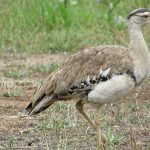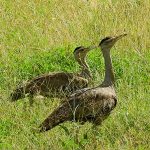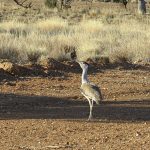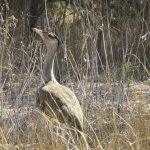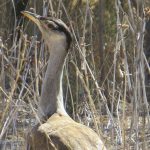AUSTRALIAN BUSTARD
Ardeotis australis
The Australian bustard is a large bird species native to Australia. It belongs to the family Otididae, which includes the bustards and korhaans.
iT is a striking bird with a tall, slender neck and long legs. Adults can grow to a height of about 1 to 1.3 meters and have a wingspan of approximately 2.3 meters. Males are generally larger than females.
The plumage of the Australian bustard is predominantly brown, with a mottled and camouflaged pattern that helps it blend in with its arid grassland and savannah habitats. The neck and head are mostly white, with some blue and red patches present on the neck and face. The male has a black band across its breast and a dark tail with white tips.
Australian bustards are found across mainland Australia, primarily in open grasslands, savannahs, woodlands, and other semi-arid to arid habitats. They are known to inhabit regions with sparse vegetation and can be found in areas with varying levels of human disturbance, from remote regions to some agricultural and pastoral landscapes.
Australian bustards are primarily ground-dwelling birds, using their strong legs to walk and run across the landscape. They are also strong fliers, using their large wings for long-distance flights between foraging areas.
Their diet consists of a wide variety of food items, including insects, small vertebrates (such as lizards and rodents), seeds, and fruits. They are opportunistic feeders and will take advantage of available food sources in their habitats.
The Australian bustard faces some conservation challenges due to habitat loss and fragmentation, as well as potential threats from feral predators such as dogs, pigs and foxes. They are also very sensitive to disturbance at breeding sites, if disturbed by humans and or livestock they are likely to leave the area. Additionally, they are susceptible to collisions with vehicles.

